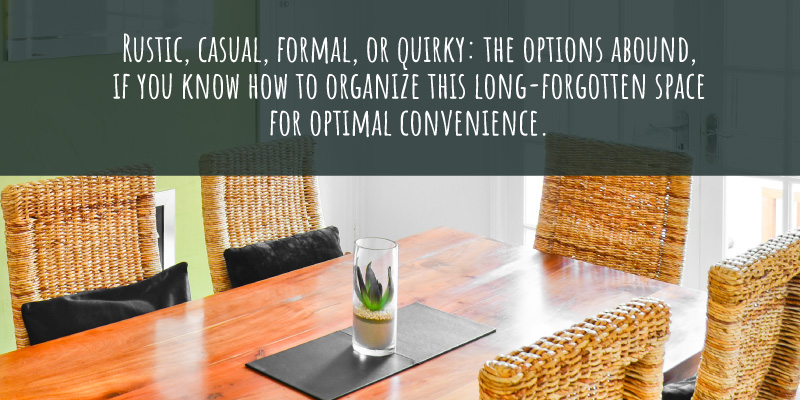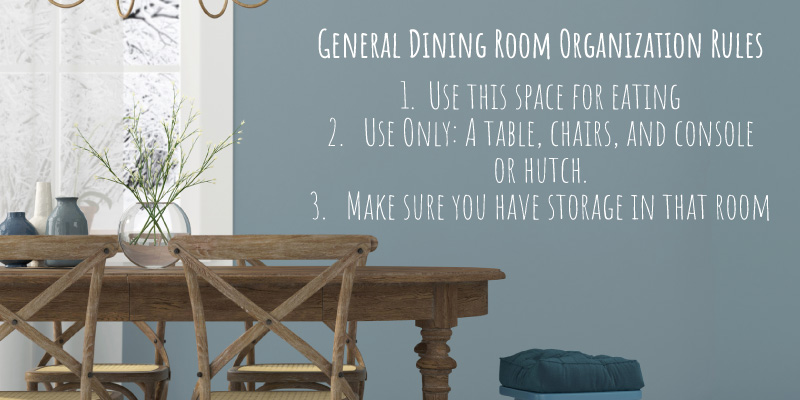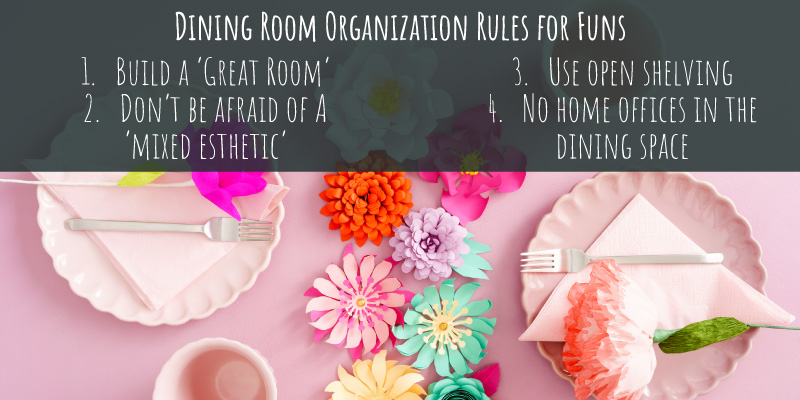How Funs (ESTP, ISTP, ESFP, ISFP) Should Organize Dining Rooms
Dining rooms have had their moment, gone totally out the window, and come back. The one message we’ve gotten about dining rooms isn’t whether they are ‘in’ or ‘out’, but whether they are something you want to have in your house or not. Dining rooms have historically served a very distinct and formal purpose: to be the spot in the house for entertaining — be it dukes or earls, or just plain dinner party guests. But as the ‘great room’ trend caught on, and meals were served more casually or at different times depending on each family member’s schedule, dining rooms faded, quite literally, into the woodwork.

Now, with a ton of articles on dining room trends for 2018, it seems they are back — with a definite twist. Wherein lies the twist? Precisely in the way each room is designed. Rustic, casual, formal, or quirky: the options abound, if you know how to organize this long-forgotten space for optimal convenience.
Fun personality types (ESTP, ISTP, ESFP, ISFP) are perhaps the exception to this rule, if only because having one big room separated into compartments makes it much easier to clean, keep track of things, and generally manage — than three separate rooms. Remember that Funs do best when they are able to get things done in the moment (which is why To Do lists are not helpful for this type), and so naturally if all of the said ‘things’ to be done are in one single room, voila! Makes the lives of Fun types a lot easier.

General Dining Room Organization Rules
Before we get into how Funs should organize their (non) dining rooms, let’s go over a few cardinal rules for these spaces that should be followed if you want your dining room to stay organized.
- Use this space for eating: In the same way people who have trouble sleeping are encouraged to use their bedroom for sleeping only (no electronics, no food, etc), we encourage you to use your dining room for eating only. Otherwise it starts to become unmanageable. Think about it. You probably use your dining room (if you use one at all) at least once a day. If you have to constantly clear the dining room table before setting it for dinner, this adds an extra (and quite annoying) step into your routine.
- Use the following pieces of furniture: A table, chairs, and console or hutch. That is it, that is all, that is the limit. Otherwise, the room starts to get cluttered and we all know how certain Funs handle clutter, don’t we? (Hint: Not very well.) Very, very crucial detail: Make sure all of these items fit easily into the room you’re using as a dining room.
- Make sure you have storage in that room: Store your china or dishes, tablecloths, linens, napkins, flatware, etc. in the drawers of your console or in your hutch for easy access — going back and forth from the kitchen to the dining room is no fun.

Dining Room Organization Rules for Funs
As we said earlier, formal dining rooms should be avoided at all costs for this type, simply because it’s another place for things to get lost and space to become cluttered. Just like paperwork in the home office, clutter in the dining room can pile up and because all Funs tend to procrastinate, this is not a good arrangement. The following is a dining room — or “non” dining room organization primer for the Fun personality type.
-
- Build a ‘Great Room’: We know that they originated in the early 1990’s. But great rooms, which are simply kitchens, dining rooms and living rooms adjoined and made into one huge living space, are perfect solutions for Funs, who need to be able to get everything done in the moment in order to get anything done at all. If everything is in the same general area, then it makes it that much easier to just do tasks in the moment, because you don’t have the excuse of having to go upstairs or to another part of the house. These gathering places can be multi-purpose: for cooking, eating, or just hanging out. As it states in our book, Organize Your Way: Simple Strategies for Every Personality, “If most of your life is all inside one big room, it allows you to effortlessly get things done the moment you think about it and have the time.”
- Don’t be afraid of a ‘mixed esthetic’: Have ‘fun’ with designing your dining space (remember, it’s not a room anymore!) and decide on a rustic vibe with colorful accents, or play with the color and texture of the walls in that area to mix things up a bit. Think of this space as the anti-formal dining room. But don’t go too crazy. Keep some structure with storage options like chests or caddies for flatware. The designated slots for each fork, knife, and spoon, etc. will make organization that much easier.
- Use open shelving: We know. It’s pretty much on the interior designer 2018’s list of things to never use. However, for the purposes of making things easier for Funs, we are big proponents of this organizational trend. With a single caveat: Use low, flat bins to store placemats, napkins, and the like, so that things stay organized.
- No home offices in the dining space: A laptop, maybe. But that is IT! Can you imagine how a pile fiend with a tendency to procrastinate would handle stacks of papers and a printer and goodness knows what else on the dining room table, only to have to find a place for those things every evening by dinnertime? Nightmare!
- Build a ‘Great Room’: We know that they originated in the early 1990’s. But great rooms, which are simply kitchens, dining rooms and living rooms adjoined and made into one huge living space, are perfect solutions for Funs, who need to be able to get everything done in the moment in order to get anything done at all. If everything is in the same general area, then it makes it that much easier to just do tasks in the moment, because you don’t have the excuse of having to go upstairs or to another part of the house. These gathering places can be multi-purpose: for cooking, eating, or just hanging out. As it states in our book, Organize Your Way: Simple Strategies for Every Personality, “If most of your life is all inside one big room, it allows you to effortlessly get things done the moment you think about it and have the time.”
